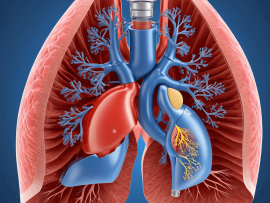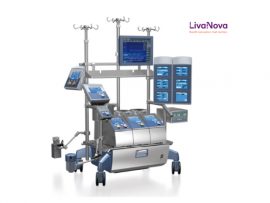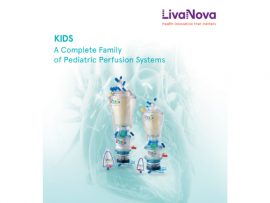Abstract Objective Conduct a systematic review and meta-analysis of the efficacy of therapeutic plasma exchange (TPE) or intravenous cangrelor to prevent thromboembolism in patients with heparin-induced thrombocytopenia (HIT) who undergo..
Read MoreAbstract Introduction: We sought to comprehensively explore the potential linear and nonlinear relationship between preoperative iron metabolism and perioperative myocardial injury (PMI) following cardiac surgery with cardiopulmonary bypass (CPB). Methods: Patients..
Read MoreAbstract Background: Decreased cerebral oximetry (rSO2) in cardiac surgery is associated with postoperative delirium (POD). However, interventions optimizing intraoperative rSO2 are inconclusive. Methods: In this prospective observational cohort study, the..
Read MoreAbstract Background and Objective Patients undergoing cardiac surgery consume more than 50% of blood transfusions, and such transfusions have been associated with increased morbidity and mortality. Evidence in blood-saving techniques..
Read MoreAbstract Heart transplantation (HT) is the gold standard treatment of end-stage heart disease. Waitlist mortality remains high due to a shortage of available donor organs. Donation after circulatory death (DCD)..
Read MoreAbstract Objective: Massive pulmonary embolism (PE) remains a life-threatening condition, often leading to acute respiratory and cardiac failure. This study evaluates the role of extracorporeal membrane oxygenation (ECMO) as a..
Read MoreAbstract Objective To explore whether ultrafiltration (UF) volume adjusted for weight is associated with an increased risk of acute kidney injury (AKI) after cardiopulmonary bypass (CPB) in cardiac surgery patients...
Read MoreAbstract Introduction Cardiotomy suction blood is used in cardiopulmonary bypass (CPB) surgery to maintain blood volume in the CPB system, although it is known to contain micro emboli, cytokines and..
Read MoreAbstract Background Understanding of the hemostatic and complement alterations associated with cardiopulmonary bypass (CPB) in pediatric patients and the impact of these alterations on outcome is limited. Objectives The present..
Read MoreAbstract Background This study examined the association between cardiopulmonary bypass (CPB) hematocrit and postoperative acute renal failure (ARF) in patients undergoing aortic arch surgery with hypothermic circulatory arrest. Methods The..
Read MoreAbstract Introduction Minimally invasive cardiac surgery (MICS) for mitral valve repair often uses cardiopulmonary bypass (CPB) through peripheral femoro-femoral cannulation. A rare complication of differential hypoxemia can cause upper body..
Read MoreAbstract Cardiopulmonary bypass (CPB) is essential for the conduct of open-heart procedures. While lifesaving, CPB can be associated with significant end-organ injuries believed to result from inflammatory responses triggered by..
Read MoreAbstract Background: Magnesium administration is a common practice in cardiovascular surgeries utilizing cardiopulmonary bypass (CPB). However, concerns persist regarding the risk of hypermagnesemia, particularly in patients with kidney dysfunction. This..
Read MoreAbstract Introduction: Mannitol, an osmotic diuretic solution, is commonly utilized in priming cardiopulmonary bypass (CPB) and can impact kidney function. This study was conducted to investigate the impact of mannitol use..
Read MoreAbstract Background Prophylactic corticosteroids have been widely used to mitigate the inflammatory response induced by cardiopulmonary bypass (CPB). However, the impact of this treatment on clinically important outcomes in infants..
Read MoreAbstract The safe use of cardiopulmonary bypass (CPB) relies upon the ability to administer, monitor, and reverse anticoagulation. Although rare, the factor XII deficient patient creates a challenge for the..
Read MoreAbstract Background: The incidence of hyperlactatemia due to hypoperfusion during cardiopulmonary bypass (CPB) increases morbidity. Carbon dioxide production during CPB is one of the lactate production markers, in addition to..
Read MoreAbstract Background Cardiac surgery with cardiopulmonary bypass (CPB) triggers pulmonary injury. In this trial we assessed the feasibility, safety, and efficacy of low frequency ventilation (LFV) during CPB in patients..
Read MoreAbstract Background The inflammatory response to cardiopulmonary bypass (CPB) in pediatric patients remains an unresolved challenge. Sanguineous CPB prime, composed of allogenic blood products, is one potentially important stimulus. This..
Read MoreAbstract Cardiac surgery-associated acute kidney injury (CSA-AKI) is a high-risk complication with well-recognized increased morbidity and mortality after cardiac surgery attributable in large part to cardiopulmonary bypass (CPB)-associated factors contributing..
Read MoreAbstract Introduction Over the past 20 years, the Pediatric Cardiovascular Department at Penn State Health Children's Hospital and College of Medicine has been researching ways to improve the safety and..
Read MoreAbstract Objectives To compare brain injury biomarker release levels between two different cardiopulmonary bypass (CPB) flow rates in elective cardiac surgery and to explore differences in postoperative delirium between groups..
Read MoreAbstract Cardiopulmonary bypass (CPB) and veno-arterial extracorporeal membrane oxygenation are critical tools in contemporary cardiac surgery and intensive care, respectively. While these techniques share similar components, their application contexts differ,..
Read MoreAbstract Introduction Surgical repair is the standard of care for most infants and children with congenital heart disease. Cardiopulmonary bypass (CPB) is required to facilitate these operations but elicits a systemic..
Read MoreAbstract Congenital heart disease (CHD) can be complicated by pulmonary arterial hypertension (PAH). Cardiopulmonary bypass (CPB) for corrective surgery may cause endothelial dysfunction, involving endothelin-1 (ET-1), circulating endothelial cells (CECs),..
Read MoreAbstract Objectives To describe perfusionist perspectives regarding waste (WAG) management during (CPB) and compare results to existing American Society of Technology (AmSECT) guidelines and the 2016 National Institute of Occupational Safety and Health..
Read MoreAbstract Background and Objectives Neonatal cardiac surgery requires careful consideration of cardiopulmonary bypass (CPB) priming fluid composition due to small blood volume and immature physiology. This study investigated the impact..
Read MoreAbstract Background: Acute kidney injury (AKI) following cardiac surgery is a well-described phenomenon, usually associated with hemodynamic changes ultimately leading to ischemic injury to the kidneys. In this study, we assessed..
Read MoreAbstract BACKGROUND: Continuous cardiac output monitoring is not standard practice during cardiac surgery, even though patients are at substantial risk for systemic hypoperfusion. Thus, the frequency of low cardiac output..
Read MoreAbstract IMPORTANCE: Persistent hypothermia after cardiopulmonary bypass (CPB) in neonates with congenital heart defects (CHD) has been historically considered benign despite lack of evidence on its prognostic significance. OBJECTIVES: Examine..
Read More



















